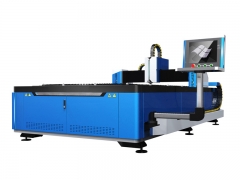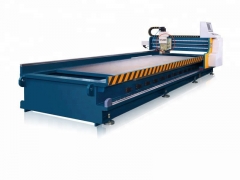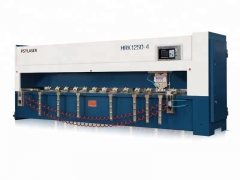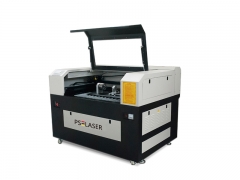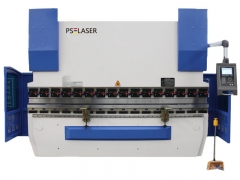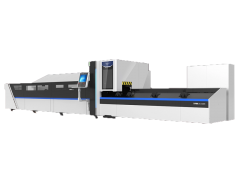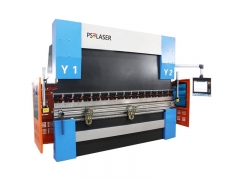Four Different Ways Press Brakes Apply Force
When you’re assessing a press brake for possible purchase, it’s essential to know which class of press brake you’re dealing with. Different machines will apply force in different ways. Let’s take a look at an overview of this concept before we go into more detail.
- Mechanical: The oldest type of press brake technology. This variation uses a flywheel powered by an electric motor to supply the force for bending materials. It is fast and accurate but has mainly been supplanted by the hydraulic press.
- Pneumatic: These press brakes utilize air pressure to move their rams up and down. They are similar to hydraulic presses but usually have a much lower tonnage limit. Tonnage is the measure of force that can be applied to an object.
- Servo electric: Servo-electric press brakes use an electric motor to drive the ram. While very fast and efficient compared to other press brake variants, they are limited to low tonnage work. One benefit is that, without hydraulic fluids and seals, maintenance is simplified.
- Hydraulic: Hydraulic fluids in one or more cylinders are used to force the ram of the press brake down onto the piece being shaped (though some models move up the bed). Hydraulic controls are generally more accurate than mechanical press brakes and can be adjusted for individual bend depths.
When talking about press brakes, people usually refer to mechanical or hydraulic press brakes, as these are the most commonly known. The decision on which press brake you should use will depend on your exact applications. If you have to do a lot of metal forming that doesn’t require a lot of tonnages, a servo-electric machine might be suitable for you. If you need to bend very thick pieces of steel, a hydraulic machine might suit your needs better.
Mechanical Press Brake
Mechanical press brakes operate via a motor inside the device. This motor spins a large flywheel at high speeds. The machine operator controls the flywheel through a clutch, which sets the rest of the parts into motion to bend the metal. The mechanical press brake is relatively straightforward in terms of electronics, making maintenance and operation easy.
The primary disadvantage of using mechanical press brakes is that the ram inside the machine must perform a complete cycle when engaged and cannot be reversed. This creates some safety concerns if the operator makes a mistake and sets some limitations on the machine. One potential hazard is the press brake becoming locked if the ram travels too far.
Pneumatic Press Brakes
The potential force from a pneumatic press comes from compressed air or gas. An electrical charge sets the machinery into motion, feeding compressed air or gas into cylinders or tubes that are connected to the press mechanism. When the gas fills the tubes, the resultant pressure forces the movement of the pressing tool, usually in a downward motion. When this movement is complete, the gas escapes through exhaust valves, and mechanical springs push the brake back into its original position.
Pneumatic presses work at very high speeds compared to hydraulic presses, which are much slower in their movements. The optimal choice between a pneumatic press and a hydraulic press comes down to the speed and pressure requirements.
Servo Electric Press Brakes
The pressing force of servo electric press brakes comes through two synchronized server motors that transfer the power with a special belt and pulley’s help. During the upper beam’s downward movement, servo motors coil the belt to the main pulley and apply the bending force. The return force is mechanical and comes from springs that are located on both sides of the machine. After bending, servo motors start to uncoil the belt, and springs push the upper beam to the original position.
The advantages of a mechanical press brake are most evident in the production of small parts. The most significant advantage of electric press brakes is the rapid acceleration of the bending ram compounded by eliminating hydraulic valve shift time between speed changes.
Hydraulic Press Brakes
A hydraulic press works on the principle of Pascal’s Law, which states that when pressure is applied to a contained fluid, the pressure change occurs throughout the entire fluid. In this type of brake, there is a piston that works as a pump to provide a modest mechanical force to a small area of the sample. There is also a piston with a larger area, which produces a more significant mechanical force.
There are a variety of advantages to using hydraulic presses. This is evident in hand-fed hydraulic presses, where the ease and speed of sample switching are considerably improved. Hydraulic presses are versatile machinery and can be used to prepare a large number of samples.
At Mac-Tech, we carry some of the finest CNC hydraulic press brakes for sale from Ermaksan. Used most often to bend and manipulate sheet metal, these CNC hydraulic press brakes allow you to make accurate bends that meet your exact specifications. The Power-Bend Falcon is among the highest-rated CNC hydraulic press brakes, which will boost your productivity and keep costs at a low level with its user-friendly CNC controller and low-cost hydraulic maintenance.
As you can see, there are four different ways that press brakes apply force in a press brake. You will have to choose which one is best for yourself. Hopefully, this article has encouraged you to investigate the different kinds of press brakes. If you find that a high-performance hydraulic press brake is the one for you, contact Mac-Tech today. Our dedicated salesforce is waiting to serve you.
 español
español English
English français
français

